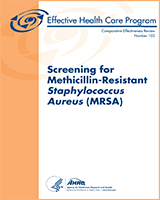NCBI Bookshelf. A service of the National Library of Medicine, National Institutes of Health.
Glick SB, Samson DJ, Huang E, et al. Screening for Methicillin-Resistant Staphylococcus Aureus (MRSA) [Internet]. Rockville (MD): Agency for Healthcare Research and Quality (US); 2013 Jun. (Comparative Effectiveness Reviews, No. 102.)
This publication is provided for historical reference only and the information may be out of date.
Study Characteristics
- First Author (last name, first name)
- Year
- Country
- Study Design
- RCT
- ITS
- QEX-BA
- QEX-CG
- X-OVER
- Intervention N:
- Rate:
- Proportion:
- Both:
- Indicate the units for the Intervention N:
- Person-Time
- Individuals
- Other
- Control N:
- Rate:
- Proportion:
- Both:
- Indicate the units for the Control N:
- Person-time
- Individuals
- Other:
- Intervention(s) (including assay type)
- Control Intervention(s) (including assay type)
- Setting
- Study duration
- Pre-defined endpoints
- Inclusion Criteria
- Exclusion Criteria
- Participant Characteristics of Intervention Group
- Participant Characteristics of Control Group
- Colonization Pressure Intervention Group
- Colonization Pressure Control Group
- Turnaround Time
- Duration of Follow-Up Intervention Group
- Duration of Follow-Up Control Group
- Source of Funding and Disclosed Author-Industry Relationships
Outcomes
- Study Description of Outcome (how did article label the outcome?)
- Study Definition of Numerator of Outcome
- Study Definition of Denominator of Outcome
- Indicate how the outcome measure is reported and specify units if rate (e.g., per 1000 patient-days)
- Rate:
- Proportion
- Both:
- Other:
- If the outcome is a rate indicate the units
- per 100 patient days
- per 1000 patient days
- per 10,000 patient days
- per 100 admissions
- per 1000 admissions
- per 10,000 admissions
- Other:
- Frequency of Outcome in Intervention Group:
- Frequency of Outcome in Control Group:
- Difference [Screening-Control (95% CI)]
- Difference Metric:
- Rate Ratio:
- Risk Ratio:
- Rate Difference:
- Risk Difference:
- Analysis (e.g., Regression, Name of Statistical Test)
- Univariate Analysis Results (variable1 (p value); ...)
- Multivariate Analysis Results (variable1 (p value); ...)
- Were covariates included in multivariate models based on univariate analysis p values?
- Yes
- No
- Uncertain
- Describe decisions for building final multivariate model.
Study Quality
- Initial assembly of comparable groups
- Yes
- No
- Uncertain
- Maintenance of comparable groups (includes attrition, crossovers, adherence, and contamination)
- Yes
- No
- Uncertain
- Avoidance of important differential loss to followup or overall high loss to followup.
- Yes
- No
- Uncertain
- Measurements reliable, valid, equal (includes masking of outcome assessment)
- Yes
- No
- Uncertain
- Interventions comparable/clearly defined
- Yes
- No
- Uncertain
- All important outcomes considered
- Yes
- No
- Uncertain
- Appropriate analysis of results (adjustment for potential confounders and intention-to-treat analysis)
- Yes
- No
- Uncertain
- Funding/sponsorship source acknowledged
- Yes
- No
- Uncertain
- Overall Rating
- Good
- Fair
- Poor
- Were baseline prognostic characteristics clearly described and groups shown to be comparable?
- Yes
- No
- Uncertain
- Were interventions clearly specified?
- Yes
- No
- Were participants in treatment groups recruited in the same time period?
- Yes
- No
- Uncertain
- Was there an attempt by investigators to allocate participants to treatment groups in an attempt to minimize bias?
- Yes
- No
- Were concurrent/concomitant treatments clearly specified and given equally to treatment groups?
- Yes
- No
- Were outcome measures clearly valid, reliable, and equally applied to treatment groups?
- Yes
- No
- Were outcome assessors blinded?
- Yes
- No
- Uncertain
- Was the length of follow-up adequate? (median/mean, range of follow-up)
- Yes
- No
- Was attrition below an overall high level (<20%)?
- Yes
- No
- Uncertain
- Was the difference in attrition between treatment groups below a high level (<15%)?
- Yes
- No
- Uncertain
- Did the analysis of outcome data incorporate a method for handling confounders such as statistical adjustment?
- Yes
- No
- Did the study design use a separate control group?
- Yes
- No
- Did the statistical analysis use regression or time series modeling?
- Yes
- No
- MRSA Data Abstraction Form Elements - Screening for Methicillin-Resistant Staphy...MRSA Data Abstraction Form Elements - Screening for Methicillin-Resistant Staphylococcus Aureus (MRSA)
- Sleep Disturbance Plots - Menopausal Symptoms: Comparative Effectiveness of Ther...Sleep Disturbance Plots - Menopausal Symptoms: Comparative Effectiveness of Therapies
- Excluded Studies - Local Therapies for Unresectable Primary Hepatocellular Carci...Excluded Studies - Local Therapies for Unresectable Primary Hepatocellular Carcinoma
- Abstract and Full-Text Review Form Templates - Medication Therapy Management Int...Abstract and Full-Text Review Form Templates - Medication Therapy Management Interventions in Outpatient Settings
- Caenorhabditis elegans MARVEL domain-containing protein (F47B3.3), partial mRNACaenorhabditis elegans MARVEL domain-containing protein (F47B3.3), partial mRNAgi|1767231512|ref|NM_001375254.1|Nucleotide
Your browsing activity is empty.
Activity recording is turned off.
See more...
